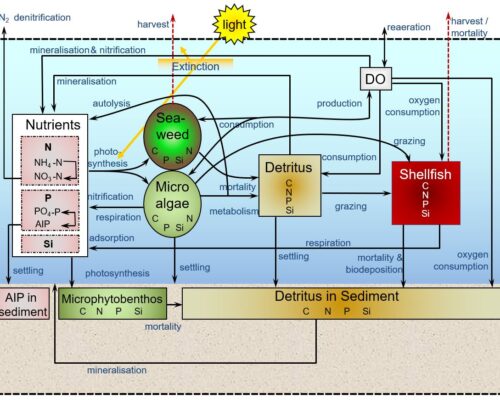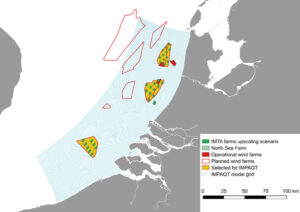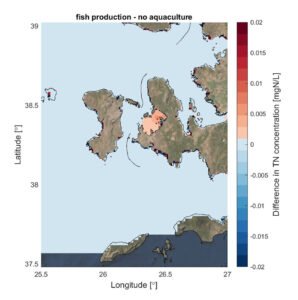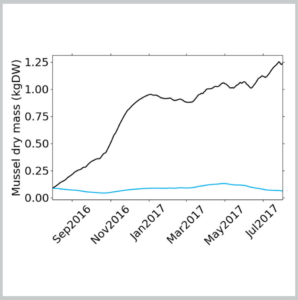Article produced by Deltares.
The use of numerical models for IMTA
In the planning stages of IMTA farms it is essential to get some information on a lot of aspects such as:
- potential yields for extractive aquaculture
- potential impacts that may be detrimental to the environment
- the best spatial lay-out to get optimal benefits from nutrient and oxygen footprints
- the “IMTA-effect” relative to single species farming.
One way of obtaining this is through numerical models that can simulate the environmental conditions as well as the growth, uptake and excretion rates of farmed organisms. Within IMPAQT such models have been developed and tested on two of the project sites. Such models are fairly complicated. They require significant calculation power and data storage facilities, and setting up and running such models requires good understanding of the physical and ecological environment and of many essential ecological processes.
What should be in an IMTA model?
Environmental processes
The foundation part of such models is hydrodynamics, i.e. water currents and movement. Water carries nutrients, oxygen and waste material towards and away from aquaculture installations. In most cases this requires a 3D model. Many marine areas are stratified. This means that the water column has layers of different densities that don’t easily mix. Nutrients available in the bottom layers that do not receive enough light are of little use to seaweed growing in the top layers. Furthermore, the model needs to give information about light penetration in the water column.
The growth of seaweed and phytoplankton depends on light. Both the presence of fine suspended sediment in the water and the presence of phytoplankton itself can increase turbidity and reduce the amount of light available for photosynthesis. Another vital aspect for the growth of phytoplankton and seaweed is the availability of nutrients. The most important are nitrogen compounds (nitrate, ammonium), phosphate and for certain groups of phytoplankton also silicate.
Nutrients can get into the water in many ways. In coastal areas this is mostly through the discharge of rivers, streams and sometimes waste water from urban areas. For more offshore areas and also for enclosed bays with little run-off from land, the exchange with the open ocean is essential. Nutrient concentrations are important but are only half the story. Even high nutrient concentrations can be depleted quickly if they are not replenished. So, the nutrient concentrations, together with the flow determine the carrying capacity for seaweed and phytoplankton.
Biological processes
The models also need basic information on the biological processes of the cultivated species. For fed aquaculture (e.g. fish) you need information on the rates at which food and excrement from fish are released into the water and how quickly they are converted by bacteria into inorganic nutrients and organic compounds that can be taken up by either extractive cultivated species or by naturally occurring species in the environment. How far nutrients are dispersed and how quickly they get diluted to background concentrations depends on local currents.
For cultivated seaweed species, you need information on the uptake rates for nutrients and how much light they need to grow. These uptake rates are different for e.g. Saccharina latissima, cultivated in the North Sea and Ulva rigida which is cultivated at the Çamli site. For example, for shellfish there is an intermediate step: phytoplankton. You need to be able to model the growth of phytoplankton, the filtration rate of the shellfish and the growth of the shellfish in relation to the environmental conditions (food availability but also temperature).
Feedback processes
There are many ecosystem models available (simple, complex, 1D, 2D, 3D), but even many of the relatively complex models are often one-way traffic. Nutrients are available for phytoplankton, which is available for shellfish and that determines how much shellfish can grow. However, for IMTA it is quite important that also the feedback effects of e.g. shellfish on phytoplankton can be resolved (see Fig. 1).
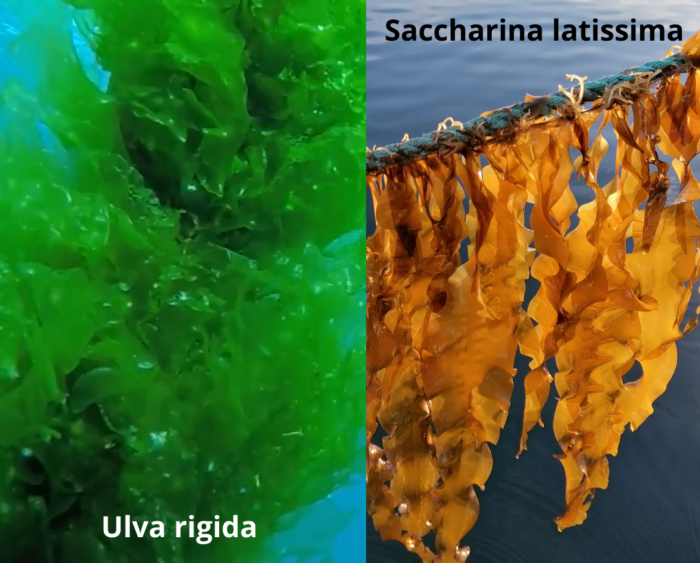
Shellfish feed on phytoplankton, but through their faeces they also ensure that nutrients become available again. It sounds paradoxical, but in areas with dense shellfish cultivation the growth of phytoplankton is larger than it would be in a similar system without shellfish. This is clearly relevant when shellfish and seaweed are cultivated in close proximity.
It is less important in areas that are very open and have a large exchange rate with the larger ecosystem. However, in enclosed bays with a large residence time, this can make a big difference. The IMTA models developed within IMPAQT can take these feed-back loops into account. This is not entirely unique for ecosystem models but not common.
Lessons learned from IMPAQT
For the North Sea Farm, a small offshore IMTA farm with seaweed and mussels in the North Sea the current impact and IMTA benefits are relatively small. This is due to the fact that the farm is in the open North Sea, with a substantial amount of water exchange through the farm. It is located in the region of influence of the Rhine, and therefore has a large nutrient supply. With the model we did some hypothetical upscaling scenarios in future wind farm areas in the Dutch part of the North Sea (Fig. 2).
Upscaling can lead to a reduction in nutrients. Further offshore the seaweed still grew well, but there was a lower mussel production, due to a lower availability of phytoplankton (Fig. 3). The oxygen production of the seaweed overcompensated for the extra oxygen demand due to mussel production.
The Çamli site has seabass, mussels and seaweed. Due to the extremely low natural nutrient concentrations and the limited water exchange in the bay, the impact of fish farming on nutrients is very large indeed (Fig. 4).
The models indicated that in this area nutrient availability is so low that cultivating mussels would not be viable without the presence of the fish farm. This immediately illustrated the IMTA benefit in this region (Fig. 5).
In the model it was not possible to get Ulva rigida, the seaweed cultivated within IMPAQT, to grow. This actually matched the field observations. Ulva is a species that is adapted to high nutrient concentrations and the ambient conditions, at even a small distance away from the fish cages were not conducive for seaweed growth. It may be possible to grow the seaweed more or less right next to the fish cages. However, this would likely not be resolved by the model. The model has a reasonable fine resolution (~500m x 500m grid cells in the vicinity of the IMTA farm) but this would not be enough to model effects at a few tens of meters.
Current state of development
IMPAQT has seen major improvements in the development of ecosystem models that can in future be used for sustainable planning of aquaculture and optimising the benefits of the IMTA concept. In this sense it has application potential for both farmers and regulators. The current models should be properly validated. Within IMPAQT a lot of data were collected but became available after the completion of the models.
Particularly for the North Sea, further developments are ongoing in other projects, where we are looking at differences in uptake rates of seaweed adapted to local conditions. One of the main adaptations we know are required, is that the interaction between the cultivation installation and the water flow needs to be taken into account. Seaweed lines and mussel ropes will slow down the flow and this depends on the season. This will influence the transport of phytoplankton and nutrients close to the IMTA site. So the current models are likely to overestimate the production a bit. For larger sites the effect is bigger than for e.g. the North Sea farm.
At present the IMTA models are still research tools to get more insight in the environmental interactions of IMTA and the natural environment. However, these models do have the potential to develop into useful decision support tools in the planning stage and as evaluation tools for regulators.







